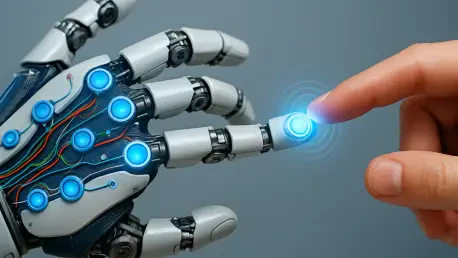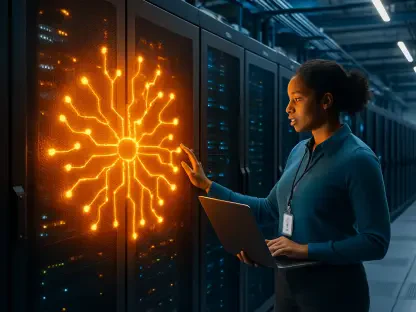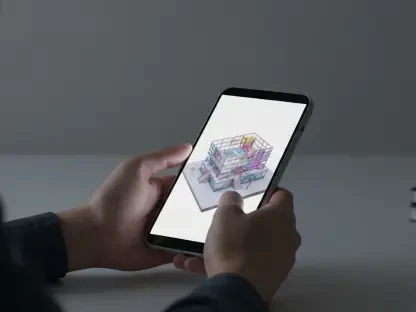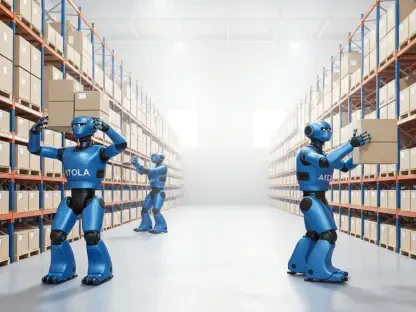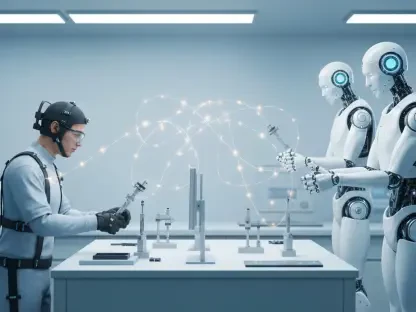Imagine a world where robots don’t just perform mechanical tasks but actually sense their surroundings with the same nuanced perception as humans, detecting heat from a distance or gauging the weight of an object with a subtle flick. This vision is becoming reality with the MOTIF Hand, a groundbreaking robotic hand developed by a team at the USC Viterbi School of Engineering under the guidance of Assistant Professor Daniel Seita. This innovative technology stands apart from earlier robotic systems by integrating multimodal sensory capabilities that mimic human-like responses to temperature and force. Such advancements are not merely technical feats; they promise to transform how robots interact in real-world environments, from industrial factories to everyday kitchens. The MOTIF Hand represents a significant leap forward, addressing long-standing challenges in robotics by blending human intuition with mechanical precision, paving the way for safer and more efficient applications across diverse fields.
The development of this cutting-edge tool also reflects a commitment to shared progress within the scientific community. Building on the foundation of the open-source LEAP Hand from Carnegie Mellon, the USC team has embraced a collaborative ethos, making their designs and research accessible to others. This approach aims to accelerate innovation, allowing researchers worldwide to adapt and enhance the technology. At its core, the MOTIF Hand is designed to replicate the natural ways humans engage with their surroundings—sensing heat without contact or adjusting grip based on tactile feedback. This human-centric focus not only enhances functionality but also opens up a realm of possibilities for integrating robots more seamlessly into daily life, whether in high-stakes industrial settings or routine domestic tasks.
Key Innovations in Sensory Technology
Sensory Breakthroughs
The MOTIF Hand sets a new standard in robotics through its sophisticated multimodal sensing capabilities, which integrate depth, force, and temperature detection into a single cohesive system. Unlike traditional robotic hands that rely heavily on visual data or basic touch sensors, this technology incorporates a range of sensory inputs to interact with the environment in a manner strikingly similar to human perception. A standout feature is the thermal camera embedded in the palm, enabling the hand to assess heat levels without physical contact. This mirrors how humans might hover near a hot surface to gauge its temperature before touching it, ensuring safety in high-heat scenarios. Such an advancement is pivotal for tasks where direct exposure to heat could damage robotic components, marking a significant departure from previous designs that lacked this protective foresight.
Another critical aspect of the MOTIF Hand’s sensory innovation lies in its ability to process multiple types of data simultaneously, creating a richer understanding of its surroundings. The integration of depth sensors enhances spatial awareness, allowing for precise navigation and manipulation of objects in complex settings. Meanwhile, the combination of force and thermal detection ensures that the hand can adapt to dynamic conditions, whether handling delicate items or operating near hazardous heat sources. This multimodal approach addresses a core limitation in earlier robotic systems, which often struggled with isolated sensory feedback. By synthesizing these capabilities, the MOTIF Hand achieves a level of environmental interaction that feels intuitive, setting a benchmark for future developments in the field and pushing the boundaries of what robotic systems can accomplish.
Force and Spatial Awareness
Central to the MOTIF Hand’s functionality is its advanced force detection, powered by inertial measurement unit (IMU) sensors that replicate human methods of assessing weight and resistance. These sensors enable the hand to evaluate an object’s properties through natural movements like shaking or flicking, much like how a person might test the heft of an item before lifting it. This capability is crucial for tasks requiring precise force application, ensuring that the hand neither crushes fragile objects nor slips when handling heavier ones. Such adaptability is a game-changer in environments where robots must interact with a wide variety of materials, offering a level of finesse that was previously unattainable in automated systems and highlighting the hand’s potential to enhance operational safety.
Equally important is the role of depth sensors in bolstering the MOTIF Hand’s spatial precision, allowing it to navigate and manipulate objects with remarkable accuracy. These sensors contribute to a comprehensive awareness of the hand’s position relative to its environment, reducing the risk of collisions or misjudgments during complex tasks. This is particularly valuable in cluttered or dynamic settings, such as assembly lines, where precision is paramount. The synergy between depth perception and force detection creates a system capable of real-time adjustments, ensuring interactions are both safe and efficient. By embedding such sophisticated spatial understanding, the MOTIF Hand moves beyond mere functionality to emulate the careful, deliberate actions humans take instinctively, paving the way for more reliable robotic assistance in varied scenarios.
Practical Applications and Future Potential
Industrial and Domestic Uses
The MOTIF Hand holds immense promise for industrial applications, particularly in manufacturing environments where precision and safety are non-negotiable. Its force-sensing capabilities enable exact control when positioning parts or assembling components, tasks that often require a delicate balance of strength and care. In factories, where robots frequently handle diverse materials under tight constraints, this technology can minimize errors and enhance efficiency. The ability to apply just the right amount of pressure ensures that objects are neither damaged nor misplaced, addressing a common challenge in automated production lines. Such precision not only boosts productivity but also reduces the risk of costly downtime, making the MOTIF Hand a valuable asset in streamlining industrial processes.
Beyond the factory floor, the MOTIF Hand’s temperature-sensing feature opens up remarkable possibilities in heat-intensive tasks, such as cooking or welding. The palm-embedded thermal camera allows the hand to detect heat from a distance, preventing damage in scenarios involving hot surfaces or materials. In a kitchen setting, for instance, it could assess the temperature of a pan or stove without direct contact, mimicking human caution and ensuring the robot’s longevity. Similarly, in industrial welding, this capability could protect the hand from overheating, extending its operational lifespan. These applications highlight how the technology transcends traditional robotic limitations, offering practical solutions that align with real-world needs and demonstrating its versatility across both professional and domestic spheres.
Redefining Human-Robot Interaction
The MOTIF Hand’s human-like sensory features signal a future where robots integrate seamlessly into daily life, functioning as intuitive partners rather than mere tools. By replicating natural behaviors—such as sensing heat to avoid burns or adjusting grip based on an object’s weight—this technology fosters a level of trust and reliability in human-robot interactions. In homes, it could assist with routine tasks like cooking or cleaning, responding to environmental cues with a human touch. In workplaces, it could collaborate alongside humans in complex operations, reducing the cognitive load on workers by handling intricate manipulations autonomously. This potential to blend into everyday settings marks a significant shift, making robots less mechanical and more relatable as they mirror human sensory logic.
Moreover, the open-source nature of the MOTIF Hand positions it as a foundation for ongoing innovation in robotics, inviting the global research community to build upon its design. By sharing their findings and technical specifications, the USC team encourages other experts to explore new applications or refine existing features, fostering a collaborative ecosystem. This approach could accelerate the development of next-generation robotic systems, potentially leading to breakthroughs in fields beyond current imagination. The hand serves as a platform for experimentation, where novel ideas can be tested and scaled, ensuring that advancements in sensory technology continue to evolve. Such a commitment to shared progress underscores the transformative impact of this project, promising a future where robotic capabilities expand in tandem with human needs.
Collaborative Spirit and Development Insights
Teamwork and Open-Source Commitment
The creation of the MOTIF Hand is a testament to the power of teamwork, with a dedicated group of USC Viterbi graduate students working under Daniel Seita’s leadership to push the boundaries of robotic design. This collaborative effort built upon the open-source LEAP Hand, enhancing its framework with cutting-edge sensory integrations that set a new benchmark in the field. The project’s success reflects meticulous coordination and a shared vision to address gaps in existing technology, focusing on human-like perception as a core principle. Each member contributed unique expertise, from sensor calibration to system integration, resulting in a cohesive tool that balances innovation with practicality. Their work exemplifies how collective dedication can yield solutions that redefine industry standards.
Equally significant is the decision to maintain an open-source approach, ensuring that the MOTIF Hand’s designs and research are accessible to the broader robotics community. This commitment fosters an environment of shared growth, where other researchers and institutions can adapt, test, and expand upon the technology without starting from scratch. By providing a transparent platform, the USC team aims to inspire rapid advancements, potentially leading to unforeseen applications or improvements. Such openness not only democratizes access to cutting-edge tools but also accelerates the pace of innovation, as diverse perspectives converge to tackle complex challenges. This collaborative ethos highlights a forward-thinking strategy, prioritizing collective progress over proprietary gains in the quest for robotic excellence.
Insights from Research and Vision
Hanyang Zhou, a recent USC graduate and key contributor to the project, emphasized the critical role of tactile feedback in the MOTIF Hand’s design, noting how it prioritizes sensory input over visual cues to mirror human interaction. This focus enables the hand to make real-time adjustments, such as modifying grip strength based on an object’s weight or texture during manipulation. Unlike earlier systems that relied heavily on pre-programmed responses, this technology adapts dynamically to environmental variables, ensuring more natural and effective engagement. Zhou’s insights underscore the importance of embedding human-like sensory logic into robotics, a principle that enhances the hand’s versatility and reliability across unpredictable scenarios, from delicate handling to robust industrial tasks.
Looking ahead, the vision for the MOTIF Hand extends beyond its current capabilities, positioning it as a catalyst for future exploration in robotic technology. The team envisions it as a springboard for novel research, where its multimodal framework can be tailored to specialized needs or integrated into larger systems. This forward-looking perspective is supported by the project’s documentation on platforms like arXiv, which details the technical underpinnings and invites scrutiny and collaboration. The emphasis on continuous improvement reflects an understanding that robotics is an evolving field, ripe with opportunities for refinement. By laying a robust foundation, the MOTIF Hand not only addresses present challenges but also anticipates future demands, ensuring its relevance as a cornerstone of innovation in human-robot synergy.
